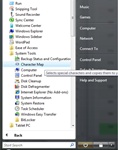How to Use Special Characters in Windows Vista or 7

Special characters are found by going to Accessories -> System Tools -> Character Map

Use the Windows Search box to quickly find the 'character map'.

You can also use the Windows Run box to open the Character Map by typing 'charmap.exe'
There may be a time when you want to use special characters in a Word document or other text file. With Windows Vista and Windows 7 you can quickly bring up a Character Map, which allows you to copy special characters or symbols, which can then be pasted into your document. To start using the Character Map in Windows follow the steps below:
- Click on Start → All Programs → Accessories → System Tools → Character Map
- The Character Map window should now be open.
- Click on the character or symbol you want to use and then click the Select button, then click the Copy button.
- Now just Paste the character that you just copied into your document.
- That's it!.
You can also open the Character Map using two other methods. The first way is to just search for Character Map in the Windows search box.
- Click on Start
- Now type Character Map in the Windows search box.
- Then click on Character Map which will listed underneath the column Programs.
The third way to access the Character Map is to launch using the Run box.
- On your keyboard press both the 'Windows' key and the 'R' key at the same time, which will pop open the Run box. (Note: the Windows key is located between the 'Ctrl' key and the 'Alt' key).
- In the Run textbox type: charmap.exe and then click OK.
So you now know how to access to all sorts of special characters and symbols directly from the Windows Character Map!